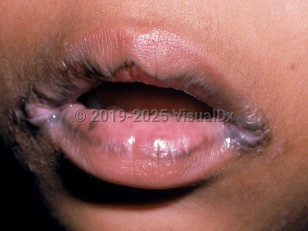Angular cheilitis - Oral Mucosal Lesion
Alerts and Notices
Important News & Links
Synopsis

Angular cheilitis affects 0.7% of individuals in the United States and is most commonly seen in children and adults aged 30-60 years.
Individuals who wear dentures that do not adequately support the facial musculature are prone to developing angular cheilitis. Patients will have accentuated folds at the corners of the mouth, leading to wicking of the saliva onto what is normally dry skin. The moist keratin acts as substrate that encourages fungal and bacterial growth.
Those who have undergone head and neck radiation, and those with diabetes mellitus (type 1 or type 2), immunosuppression, and depletion of normal oral flora (from prolonged antibiotic use) are prone to developing oral candidiasis, including angular cheilitis.
Angular cheilitis is also seen in the setting of iron; vitamin B2, B3, B6, or B12; zinc; and folate deficiency, although these represent a much less common cause of angular cheilitis.
Angular cheilitis is reported to be more common in individuals with inflammatory bowel disease (Crohn disease and ulcerative colitis), orofacial granulomatosis, and Sjögren syndrome.
Related topics: actinic cheilitis, cheilitis, exfoliative cheilitis, granulomatous cheilitis
Codes
K13.0 – Diseases of lips
SNOMEDCT:
266429005 – Angular cheilitis
Look For
Subscription Required
Diagnostic Pearls
Subscription Required
Differential Diagnosis & Pitfalls

Subscription Required
Best Tests
Subscription Required
Management Pearls
Subscription Required
Therapy
Subscription Required
Drug Reaction Data
Subscription Required
References
Subscription Required
Last Updated:09/20/2023
 Patient Information for Angular cheilitis - Oral Mucosal Lesion
Patient Information for Angular cheilitis - Oral Mucosal Lesion- Improve treatment compliance
- Reduce after-hours questions
- Increase patient engagement and satisfaction
- Written in clear, easy-to-understand language. No confusing jargon.
- Available in English and Spanish
- Print out or email directly to your patient


